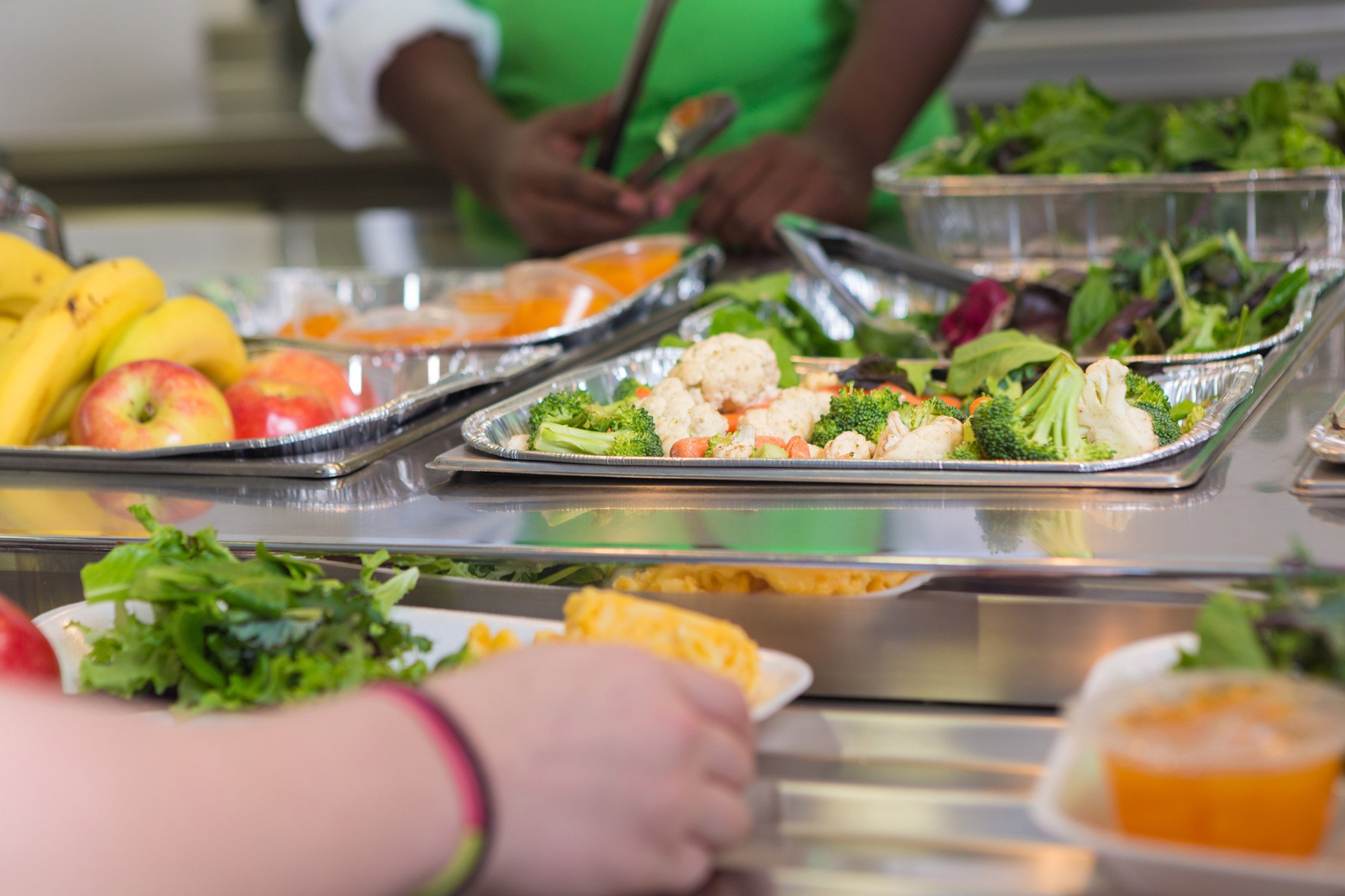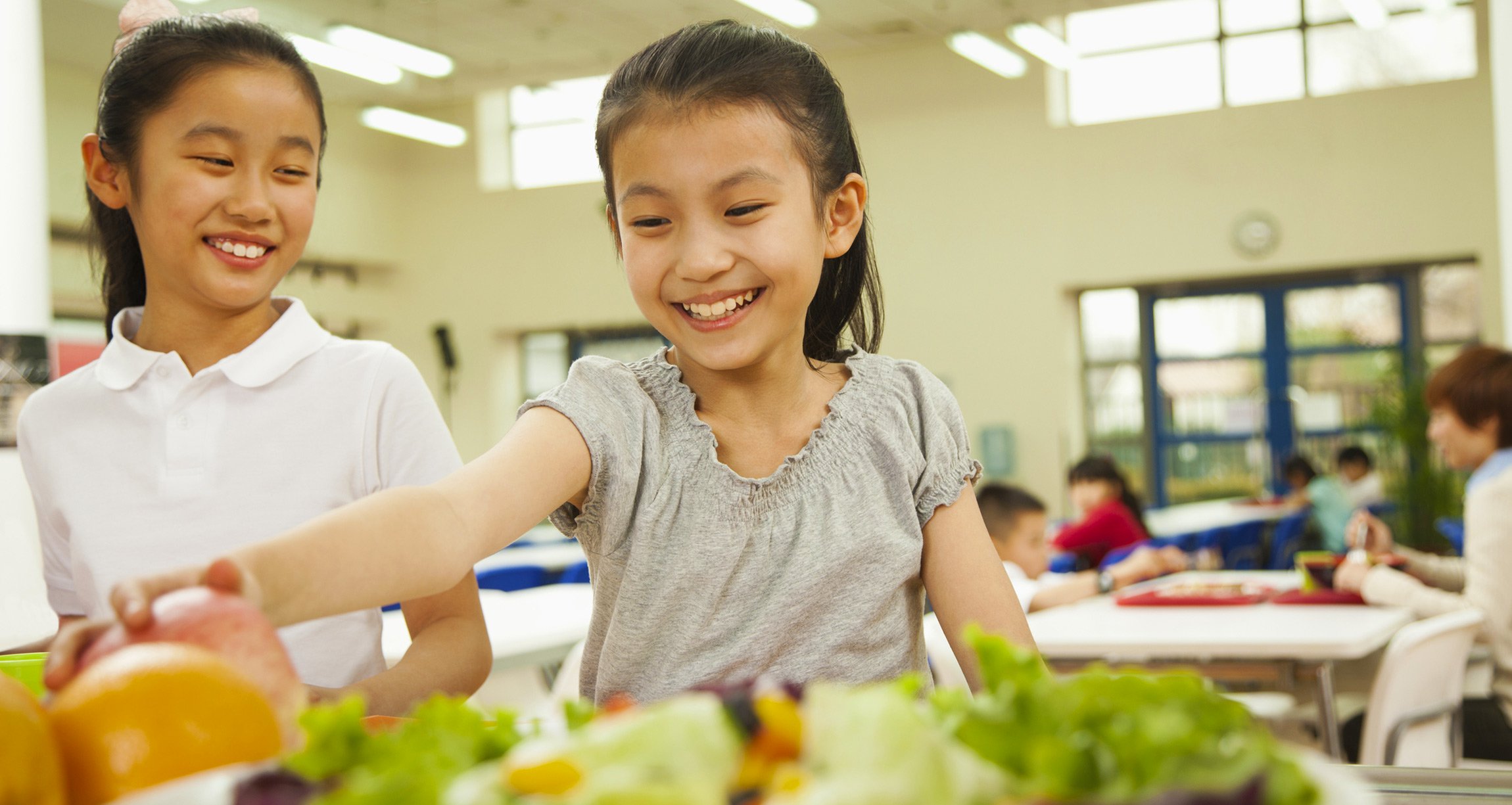School lunches in America are known for being unhealthy. However, more and more schools across the country are taking the plates (and health) of their students into their own hands and finding ways to improve the food they serve. Discover 10 ways school lunches are changing for the better — plus, healthy and easy school lunch ideas!
When students go back to school, what will they be eating for lunch?
In America, 30 million students eat midday meals served by schools every day. Every meal looks different, but more often than not, students are eating items like popcorn chicken with dipping sauce, cheese pizza, and fish sticks with mac and cheese.
School lunches typically aren’t fresh or prepared from scratch. Instead, students are often served highly processed foods that are lacking in nutrition. And when fruits and vegetables are available, they’re frequently presented in unappetizing ways.
But across the country, school lunches are getting better in some remarkable ways.
10 Ways People are Improving School Lunches
From more local food to gardens and more plant-powered options, school food is getting better in some schools. For example:
1) Farm to School Programs
The Farm to School Network offers resources to help child nutrition providers add and promote local foods in school cafeterias. The Farm to School Program, through the USDA, also offers resources and grants to help incorporate local foods, increase education, and expand school gardens.
Farm to school programs can help grow school gardens and incorporate local foods into school meals. They also promote other activities to support improved school lunches and encourage students to enjoy healthy foods.
Research has shown that these programs can encourage healthy eating habits and that participants are more likely to try fruits and vegetables.
2) Increase in School Gardens
Across the U.S., school gardens are flourishing. From indoor tower gardens in Vermont to raised beds in New York City and native food gardens in tribal communities, the 2015 USDA Farm to School Census indicates that there are now more than 7,000 school gardens.
At a middle school in California, chef and author, Alice Waters, created an edible schoolyard project, a one-acre garden, and a kitchen classroom.
Students at Brockman Elementary School in Columbia, South Carolina, are taught nutrition education in the school’s garden and throughout the curriculum:
Principal Eunice C. Williams told PEW: “Healthy eating is either a way of life or it is not. We don’t want our children to grow up thinking that taking care of your health is something they should do only when it’s convenient.”
Healthy eating is either a way of life or it is not.
3) Adding More Salad Bars to Schools

The Let’s Move Salad Bars to Schools program, launched in 2010, is an alliance among chef Ann Cooper, produce associations, and grocers. The goal is to have a salad bar in every school in America.
Salad bars give students variety and choice. And research shows that incorporating salad bars into school lunches increases children’s consumption of fresh fruits and vegetables.
4) A Public School District That Successfully Sources Health-Focused and Sustainable Foods
In 2016, the Oakland Unified School District in California partnered with the Center for Good Food Purchasing to source foods from local farms and companies that provide nutritious, minimally processed ingredients — and that follow fair-labor practices and pay employees a living wage.
Over the course of two years, the school district reduced the animal products it serves by 30%. And much of the meat still served was purchased from carefully chosen pasture-raised sources.
The district found that sourcing higher quality, more nutritious, more locally sourced food and preparing more meals onsite can create healthy meals students enjoy — even when working within a budget.
5) A Public School District that Eliminated Processed Food and Unhealthy Ingredients
The Berkeley Unified School District in California has eliminated:
- Processed food, including all hydrogenated and partially hydrogenated oils;
- High-fructose corn syrup, refined sugars, and refined flour;
- And chemicals, dyes, additives, and nitrates.
Cafeterias are also serving local organic milk and local and/or organic fruits and vegetables as much as possible.
6) How One School in Detroit Changed School Food for the Better
School meals in Detroit, Michigan, no longer serve chicken nuggets, hot dogs, and corn dogs. Now, they serve fresh fruit, green salads, lean meat, and whole grain bread.
Once a week, the students are introduced to a new raw vegetable, such as jicama, sugar snap peas, or asparagus.
And Detroit public schools now buy 22% of their produce from farms within the state of Michigan.
7) How One Low-Income School in Oregon Serves Fresh, From-Scratch Meals Daily
At the Kids Unlimited Academy (KUA) in Medford, Oregon, three healthy meals a day are prepared from scratch for more than 300 kids for the past year. Nearly all the students live below the federal poverty line, 80% are Latino, and almost half do not speak English in the home.
“If we’re really going to try to change their lives, we need to realize we are their primary source of nourishment,” said Executive Director, Tom Cole.
8) Plant-Based School Lunch Options Offered at America’s 2nd Largest School District and Other Schools in the Country

After a successful pilot program offering plant-based school lunches at seven Los Angeles schools, the Los Angeles Unified School District could become the first in the nation to provide a vegan lunch option at every school.
These changes came about thanks to Lila Copeland, a student and a youth director for the nonprofit Earth Peace. Copeland plans to take her proposal for a daily vegan entrée to the California Department of Education. And her goal is to provide every student in California with the option to select plant-based entrées and nondairy beverages by the time she graduates high school in 2020.
Plant-powered school lunch options are also available at 1,200 New York City public schools. And New York now has at least three all-vegetarian elementary schools, with options such as lentil sloppy Joes, braised black beans with plantains, and teriyaki crunchy tofu.
9) Meatless Mondays in Schools Across the U.S.
More than 50 school districts across the U.S. have begun observing Meatless Mondays.
According to Miguel Villarreal, the Novato Unified School District Director of Food and Nutritional Services in Novato, California, “Meatless Monday allows me to continue educating our students, teachers, and community about the benefits of eating more plant-based foods and less meat.”
In New York, Meatless Mondays will initially launch as a pilot program in 15 public schools in Brooklyn. If this initial program proves successful, the city’s entire public school district could participate in the future. The plan is supported by Brooklyn Borough President Eric Adams, who successfully reversed his type 2 diabetes using a plant-based diet.
10) New York City Schools Could Become the First to Ban Processed Meat
In March 2018, Adams also introduced a resolution to the New York City Council that would remove processed meat from the city’s school lunches.
The resolution cites a 2015 report from the World Health Organization that declared processed meat, such as hot dogs, pepperoni, bacon, sausage, and deli meat, can be carcinogenic to humans.
Adams said: “We cannot continue feeding our children substances that are scientifically proven to increase their chances of cancer later in life.”
We cannot continue feeding our children substances that are scientifically proven to increase their chances of cancer later in life.
Healthy School Lunches Around the World

Many countries around the world are providing quality, cost-effective meals for students.
Here are some positive signs for school lunch:
- In France, by law, at least 50% of school meals must include vegetables.
- In 2017, the European Union announced plans to invest in a new program to help cover the cost of school lunches — and to subsidize the inclusion of fruits and vegetables.
- A public campaign in the UK seeks to improve plant-based options in schools. They want to make five significant changes: making meat-free meals available every day, ensuring these meat-free options vary from meat-based meals, mandating one completely meat-free day per week, ensuring the equality of meat-free meals to meat-based meals, and eliminating all processed red meat from the menus.
- In Japan, school meals are a source of national pride. Food for school lunches is grown locally and almost never frozen.
- In Brazil, nutritionists create the lunch menu and food handlers prepare meals fresh and from scratch. They have a 30% minimum quota for using organic agricultural products from local farmers.
Benefits of Making School Lunches for Your Kids When They Go Back to School
If the meals served at schools aren’t healthy, bringing lunch or making lunch for your kids could be a great way to go.
Some reasons to pack a healthy lunch:
- You know what goes into the food you eat or serve your kids
- Your kids can enjoy favorites they might not get at school
- You can create healthy, balanced meals
- Your kids can learn responsibility by helping to make their school lunch or preparing it on their own
- Your kids will have more time to eat, relax, and socialize during lunchtime
- You can decrease food waste by giving your kids leftovers
Healthy School Lunch Ideas That Are Plant-Powered and Easy to Create

In order for kids to eat their lunch, meals need to be convenient, easy to eat, and delicious cold or at room temperature.
Here are some ideas for creating healthy school lunches:
- Bowls — Try adding a variety of foods in a bowl, such as quinoa with black beans and veggies, zoodles with veggies, and lentil salads. Try this quick and easy Hearty Bean Salad from Emma at PlantPlate. Or give kids something comforting and nutritious with this Mac and Peas recipe from Joel Fuhrman, MD. You might also get inspiration from Buddha bowls, which combine grains or starches with colorful vegetables, and legumes/beans or tofu, and sometimes fruit all in one dish. They can be gorgeous and appealing (even for fussy eaters). Get some plant-powered Buddha bowl ideas from Forkly.
- Burritos and wraps — There are so many healthful options, such as bean burritos, tahini and red pepper rolls, plant-based chickpea “tuna” salad, collard wraps, veggie sushi rolls (try this gorgeous recipe for Raw Veggie Nori Rolls from Jenn at Neurotic Mommy), and plant-powered pita pizzas.
- Sandwiches — Go beyond the expected with ideas such as cucumber and hummus, apple and nut butter, avocado and veggies, and veggie burgers. For spreading on sandwiches, you can make traditional hummus with chickpeas or try other varieties, like this White Bean Hummus from Dreena Burton.
- Pasta salad — Make whole grain or bean pasta and then add some beans and veggies and sauce. Try this Easy and Healthy Greek Pasta Salad from Heather at SoFabFood.
- Salad in a jar — Meals in a jar are portable and convenient. Emilie Eats has some great ideas for Crunchy Asian Salad, Mexican Black Bean Salad, Fruity Kale Salad, and Greek Chickpea Salad.
- Healthy sides and snacks — Sides and snacks are a must! Here are some ideas: fresh fruit and seeds, nuts, roasted chickpeas, kale chips, celery logs with nut butter and raisins, energy balls, homemade granola bars, chia seed puddings, and veggies and hummus. Try this Banana Chia Pudding from Stacey at My Kids Lick the Bowl or this simple and tasty Broccoli Tater Tots recipe from Roxy and Ben at So Vegan.
For more ideas and recipes:
- Dreena Burton has a chapter in her book Plant-Powered Families dedicated to packing healthy school lunches.
- The Physicians Committee for Responsible Medicine has some healthy school lunch menu ideas.
Whether You Pack Lunch Or Not, Remember: Children Are Our Future
What we feed our children says a whole lot about what kind of a society we are — and what kind we will become. Many parents are packing lunches for their kids, and that can be wonderful — for their families. But what about everyone else?
What about the single parents who must work two jobs and don’t have the time to prepare a healthy meal when they get home at 2 a.m.? What about the families that are short on cash and who depend on the school meal program for affordable meals?
Whether you have kids in school or not, we all have a stake in the health of the next generation. That’s why it’s so important to take action for healthy school lunches for every child. See action steps you can take here.
Can you imagine school lunches that are made from scratch and are tasty, healthful, and balanced, with fresh fruits and vegetables that students actually eat (and enjoy!)?
This vision is possible. And by working together, we can make it into reality.
Tell us in the comments:
-
What are your favorite healthy school lunch ideas?
-
Do you know any other ways school lunch is improving?




